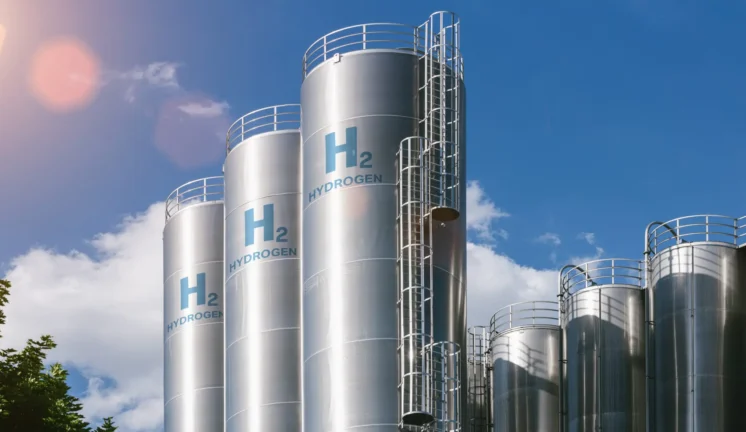Superambitious criteria of the European Hydrogen Bank and Berlin policymakers‘ cold feet result in stalled EU clean-hydrogen projects. As a result, German companies may lose dozens of millions in subsidies.
A German hydrogen project in the Baltic port of Lubmin has hit bureaucratic turbulence, exposing broader challenges in Europe’s race to scale up clean energy. Deutsche Regas, an energy infrastructure firm, will abandon €112m in EU subsidies for a planned electrolysis plant—a decision emblematic of regulatory delays clouding the continent’s green transition.
“After careful review, we have decided not to make use of the approved funding,” a company spokesperson said on 13 August, warning the move “could also lead to delays in the further progress of the project.” The culprit? Germany’s failure to transpose the EU’s revised Renewable Energy Directive (RED 3) into national law, leaving investors in legal limbo.
A ripple effect
The H2-Hub Lubmin had been one of just two German ventures selected for backing by the European Hydrogen Bank in May. To qualify, projects must start operations by 2030 and post financial guarantees upon accepting grants. The other beneficiary—Meridiam’s Kaskade project in Wilhelmshaven—remains silent on its plans.
After careful review, we have decided not to make use of the approved funding. — Deutsche Regas spokesperson
Cross-border ripple effects are emerging: Dutch developers Vattenfall and Copenhagen Infrastructure Partners recently scrapped bids for Hydrogen Bank funds for their Zeevonk scheme, though that retreat stemmed from delays to the Delta Rhine Corridor pipeline rather than regulatory holdups.
Brussels is losing patience. The European Commission has launched infringement procedures against all EU states except Denmark over sluggish RED 3 adoption. The rules mandate that 42 per cent of industrial hydrogen and one pe cent of transport fuel must be renewable by 2030, with green certification systems to match.
You might be interested
Legal limbo
Germany’s cabinet has yet to schedule legislation to enact these targets, leaving firms unable to lock in long-term contracts. “An uncertain regulatory environment hampers the ability to conclude long-term contracts with industrial customers,” Deutsche Regas noted. Tt may still reapply for funding in 2026.
The stakes transcend Lubmin. Without RED 3 implementation, Germany cannot issue binding “guarantees of origin” for renewable hydrogen derivatives like e-fuels. The gap undermines subsidy claims and quota compliance.
“There’s no way to count their use toward quotas or receive subsidies,” a trade association spokesperson stressed. Clarity on future demand also falters. The rules shape not just renewable hydrogen markets but how lower-carbon alternatives integrate into funding frameworks.
Unrealistic targets
Part of the story lies in the renewable hydrogen production and demand targets for 2030 being overly ambitious. This is not what a fringe group of MEPs says; the European Court of Auditors (ECA) does. “Based on the available information from member states and industry, the EU is unlikely to meet them (targets) by 2030,” the Luxembourg-based body said in mid-July.
The Commission was only partially successful in creating the necessary conditions for the emerging hydrogen market and the hydrogen value chain in the EU, the ECA said. Citing the Commission’s targets of 10 million tonnes for renewable hydrogen production and imports by 2030, the report said that these targets “were driven by political will rather than being based on robust analyses.”
(Hydrogen targets) were driven by political will rather than being based on robust analyses. — the European Court of Auditors
The Court noted that founding a market for renewable hydrogen requires large private and public investments along the entire value chain. According to the report, “the Commission does not have a complete overview of these needs or the public funding available.”
A cautionary tale
Berlin’s approach adds complexity. The economy ministry rejects firm-specific green hydrogen quotas, preferring sector-wide targets. “We do not enforce the targets at a company-specific level,” a spokesperson said, hinting at potential monitoring mechanisms. For transport, a draft rule linking hydrogen use to greenhouse-gas quotas is undergoing interdepartmental review—a sliver of progress in an otherwise stalled policy landscape.
The Hydrogen Bank’s €1bn second funding round hangs in the balance. While the Lubmin and Zeevonk setbacks differ in cause—one regulatory, one infrastructural—they signal how Europe’s hydrogen ambitions rely on synchronising legal, financial and engineering gears.
Deutsche Regas’s retreat thus offers a cautionary tale. Without swift RED 3 adoption, the bloc’s clean-energy vision risks deepening the sinkhole under the projects it aims to promote.











